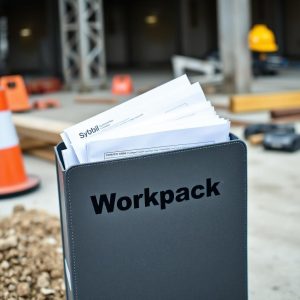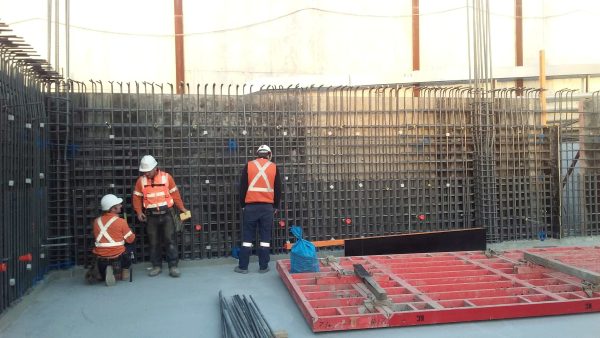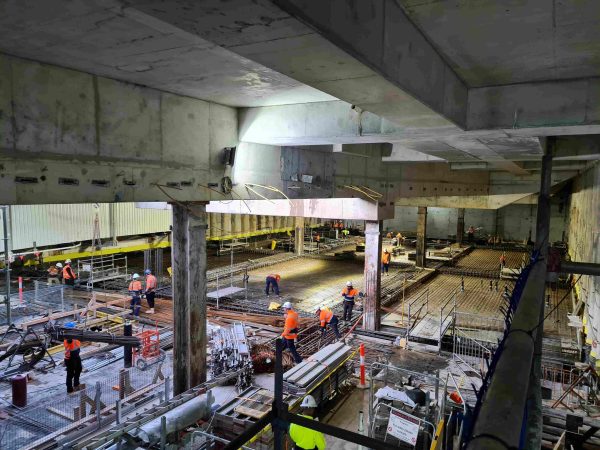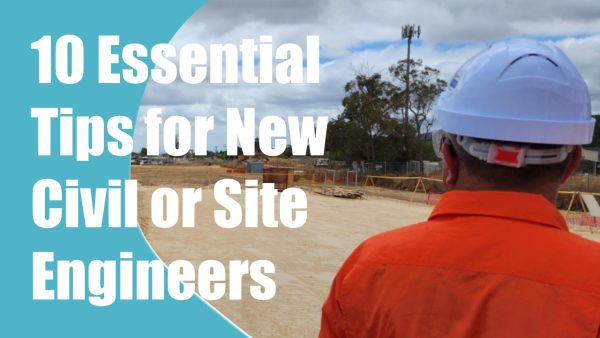Statistics and Overview
Typically, there are approximately 2300 Site Engineering roles in Australia advertised on Seek and over 2000 on LinkedIn at any one time. 2000 to 3200 civil engineers graduate from Australian universities annually.
Australia’s jobs market for Site Engineering roles is buoyant and continues to grow with a solid pipeline of infrastructure and building work on the horizon.
Years of Experience: 0 to 5 years
Salary Range: $80k to $120k
Reporting to: Project or Senior Project Engineer
Interacts with: All site team (labourers, trades, contractors, supervisors, Project engineers, safety team)
Typical Working Hours: Dependent on site, but typically 7 am to 5 pm
Qualifications and Routes to Site Engineering Roles
Let’s start with the qualifications required to acquire a Site Engineering role in Australia. There are a couple of routes to achieving an on-site role.
One can take the traditional route and become degree-qualified by obtaining a Bachelor of Engineering Degree, typically in Civil Engineering. You should check your engineering degree for accreditation with Engineers Australia. After this you can apply for a graduate engineer role with a company and progress to a Site Engineering role.

Another option is to obtain a TAFE Advanced Diploma of Civil Engineering as a second option to secure a Site Engineering role without immediately attending university. You will be recognized as an Engineering Associate under the Dublin Accord. Many Australian universities are willing to place you in the 2nd year of a civil engineering degree course. You could begin a Site Engineering role after the TAFE Diploma to gain practical experience. Then decide if you want to pursue the qualification to degree level.
So, now that we understand the qualifications required, let’s look at what a Site Engineer will manage and the expectations of the role.
Planning & Delivery
When we think of a Site Engineering role in Australia, we often imagine that we will be primarily solving technical issues. While this is partially true, site-based engineers are essentially junior project managers. They are assigned a package (or packages) of work with a certain level of risk. They manage the technical and delivery aspects of these works.
The Senior Project Engineer or Project Engineer will manage the project schedule. They look at work 6 to 12 months in advance and guide the Site Engineer on when to be ready with work items.
The Site Engineer follows and maintains a 4-week lookahead. This 4-week lookahead will break the project schedule down in far more detail. A competent Site Engineer plans 4 weeks ahead for their area and work packages. They serve as the point of contact for interfacing teams on-site. Their role requires them to sort out interface issues at the site level. They escalate to senior team members if they cannot find a solution on site.
Commercial, Procurement & Forecasting
In general, a site engineer will be involved in the following commercial & forecasting tasks, although depending on team size, you may be involved in more.
Commercial Tasks
- Reviewing delivery dockets and confirming goods have been received in good condition, then confirming payments can be made.
- Assisting the commercial team with variation and claim reviews.
- Providing cost information to the commercial team and the Senior Project Engineer for cost risk reviews.
- Providing site records & diaries as evidence when reviewing claims.
Procurement Tasks
- Procurement of minor materials and plant as requested. Usually involves sourcing 3 quotes and reviewing to check best value. Then raising requisitions.
- Quantity take-offs for forecasting, material procurement & purchasing.
- Creating documents for procurement and tendering purposes:
- Scope of works
- Pricing schedules
- Staging diagrams
- Programs
- Collating specifications, design packages & design information for inclusion in tender packs.
- Completing tender analysis sheets once tender submissions have been received.
Forecasting Task
- Reviewing hourly dayworks or plant & materials dockets and tracking against forecast spend.
- Reviewing design packages and compiling take-offs
- Updating forecast sheets with tender return rates
Materials & Resources
Depending on the contract set-up, the main contractor may freely issue materials and resources, or the subcontractor may supply them. Either way, the Site Engineer should monitor material supply to ensure its timely delivery and availability on-site.
Additionally, the Site Engineer should check the materials for compliance with project specifications. If there are any discrepancies from the specifications, the Site Engineer should raise an RFI or seek approval from the designer or architect.
Knowing the lead times for the supply of construction materials and the onboarding of contractors is also essential. For example, approximate lead times for common materials are listed below. Without appreciating this, you will inevitably face project delays.
- You can book a load of concrete 48 hours in advance.
- Concrete consumables – 1 week
- Reinforcement – 4 weeks (including scheduling)
- Drainage pipes – 6 to 8 weeks
- Structural steel – 12 weeks (shop drawings, review, material procurement, fabrication, surface treatment)
- Bespoke precast concrete may take 20 weeks (shop drawings, material procurement, review, casting, curing)
This is why the Project or Senior Project Engineer should identify longer lead items. Procurement of longer lead items is managed separately from the Site Engineer’s tasks.
Without materials, we can’t build anything. One of the biggest stresses on site is the uncertainty of when materials will arrive.
Work packs & Communicating Information
Clear communication and directions to the various workers and teams on site are critical in a Site Engineering role. The Site Engineer funnels information from designers to the site delivery team. The “Work Pack” is a useful planning and compliance tool for this purpose.”

The Site Engineer does not write all documents within a Work Pack or method statement. Part of their role is to ensure an up-to-date copy is available on site for the work crew. The Site Engineer must also understand the work pack contents.
We will cover the finer details of a “Work Pack” in a separate article. The table below outlines what items a Site Engineer may be responsible for producing and/or reviewing in a typical Work Pack.
| Methodology Documents | Prepare | Review / Approve | Final Review (dependent on risk level) |
| Method Statements | Project Engineer | Senior Project Engineer | Project Manager |
| Safe Work Method Statement or SWMS | Site Engineer | Safety Advisor | Project Manager |
| Task Sheets | Site Engineer | Project Engineer | N/A |
| Logistics or vehicle management plans | Logistics Supervisor | Logistics Manger | N/A |
| Change management procedure | Project Engineer | Senior Project Engineer | Project Manager |
| Design Information | Prepare | Review /Approval | Final Review |
| Approved or Issued for Construction Drawings | Site Engineer (print & put in folder) | N/A | N/A |
| Approved shop drawings | Site Engineer (print & put in folder) | N/A | N/A |
| Sketches | Site Engineer (print & put in folder) | N/A | N/A |
| Programme or schedule | Prepare | Review /Approval | Final Review |
| 4 week lookahead | Site Engineer | Project Engineer | N/A |
| Daily lookahead | Supervisor | Senior Supervisor | N/A |
| Sub-contractor programme | Subcontractor | Project Engineer | N/A |
| As-built Programme | Site Engineer | Project Engineer | N/A |
| Temporary Works | Prepare | Review /Approval | Final Review |
| Temporary Works Register for the works | Project Engineer | Temporary Works Coordinator | Project Manager |
| Approved Temporary Works designs | Project Engineer (Temporary Works Supervisor) | Temporary Works Coordinator | Project Manager |
| Permits to load or unload | Project Engineer (Temporary Works Supervisor) | Temporary Works Coordinator | N/A |
| Inspection records | Project Engineer (Temporary Works Supervisor) | Temporary Works Coordinator | N/A |
| Cranes & Lifting | Prepare | Review /Approval | Final Review |
| Lift Plans | Project Engineer (appointed Person) | Lift Supervisor | Project Manager |
| Lifting equipment details & registers | Project Engineer (appointed Person) | Lift Supervisor | Project Manager |
| Quality Documents | Prepare | Review /Approval | Final Review |
| Inspection & Test Plans or ITPs | Project Engineer | Quality Manager | N/A |
| Inspection & Test Records ITRs | Project Engineer | Quality Manager | N/A |
| Specifications and procedures | N/A | Quality Manager | N/A |
| Material Approvals | Site Engineer | Project Engineer | N/A |
| Work Permits | Prepare | Review /Approval | Final Review |
| Excavation, hot works, electrical, confined space permits | Permit issuers (can be Site Engineers) | ||
| Safety & Emergency | Prepare | Review /Approval | Final Review |
| Emergency procedure and contacts | Safety Advisor | Safety Manager | Project Manager |
| First Aiders | Safety Advisor | Safety Manager | N/A |
| Rescue Procedure | Safety Advisor | Safety Manager | Project Manager |
| Environmental Control Plans | Environmental Advisor | Safety Manager | Project Manager |
Record Keeping
Given the title, a Site Engineer should be on site more than any other engineering role. They are the eyes and ears of project performance on the ground – what is and isn’t working.
A Project Manager, Superintendent, or Senior Project Engineer expects a good Site Engineer to come to them with issues and suggestions for improvement. It’s amazing how a slight change in methodology influences the safe or productive delivery of an activity.

As part of the Site Engineering role, taking daily photos, and keeping records is essential. These records assist the management and commercial team in clarifying what happened in the event of a dispute. Well-considered and recorded information also assists in planning and forecasting the productivity of future activities.
Most Tier 1 contractors have specific diary or record-keeping software in use. This includes a template that the Site Engineer completes daily. The template will typically include:
- Date
- Weather and weather events
- Contractors on site
- Number of trades
- Plant on site
- Deliveries that day
- % Planned or target activities
- % Actual activities completed
- Delay events or reasons for not achieving targets.
One crucial piece of advice is to form the habit of completing diary entries daily. A fantastic way to keep on top of this is to use your phone. Take a photo of events throughout the day as reminders. Then set 15 minutes aside at the end of each shift to complete your diary entries. You would be surprised how records pay dividends later.
Technical Knowledge
The Site Engineer reviews drawings and specifications in more detail than anyone else in the team. This ensures the installation of works on site are checked and meets the specification.
Is the Site Engineer expected to understand and cite specifications from memory? Absolutely not, but being able to locate, review, and implement the requirements of these specifications is a vital skill.
There are more benefits to possessing technical knowledge and familiarity with specifications than just ensuring the works are installed correctly. Technically experienced engineers will understand the durations of activities required due to specification criteria, specialized contractors and plant requirements, materials sources, local limitations, and the methodologies to choose to deliver works effectively.
Technical knowledge of real value comes from combining your understanding of what is written in specifications and also experiencing the delivery of the activity on site.
A perfect example of this would be reading the RMS Specification 812 on Bored Piling. Reading the specification provides methodology requirements along with Hold Points.
What it doesn’t cover is how the works are staged, sequenced, selection of plant, set-up, specific methodology for operations, lifting plans, polymer pumping, and storage of materials. All these details are learned from firsthand exposure and asking the piling crew and manager specific questions.
Whenever the opportunity to experience delivery of a current activity or methodology arises, spend a day on site watching the entire process and learn from the people delivering the work. This is the best learning to improve your technical knowledge.
Design Exposure
Are Site Engineers exposed to design-related work?
Yes, but the depth of exposure depends on which stage of the project lifecycle you join the team. If you join the project early enough, you may get the opportunity to review design packages. Design packages are typically developed in stages.
Design stages are usually described as:
- Initial Detailed Design (IDD), 20% of IFC design
- Substantial Detailed Design (SDD), 80% of IFC design
- Final Detailed Design (FDD), 100% of IFC design
- Issued for Construction (IFC)
Often, a project team is formed before the construction phase. This is where you will get the above design review opportunity. This engineering team will remain and deliver the works during the construction phase. Collaborating with designers, implementation of more efficient construction methods can be achieved by requesting changes during these reviews.
During the construction phase, Site Engineers may also influence design, but usually to a lesser extent. Understanding the design and details will allow you to challenge less efficient designs and propose construction methodologies and design changes that save time and cost.
This is achieved through the RFI process. Taking your experience from previous projects or feedback from the delivery team will often drive these changes. Substituting off-the-shelf items in lieu of bespoke-designed details can often make for considerable savings.
Temporary works
Temporary works can be described as providing an “engineered solution” that is used to support or protect either existing structure or the permanent works during construction, or to support an item of plant or equipment, or the vertical sides or side slopes of an excavation during construction operations on site or to provide access. It is used to control stability, strength, deflection, fatigue, geotechnical effects, and hydraulic effects within defined limits. (“Temporary Works Risk Guidelines – Engineers Australia”)
In a Site Engineering role, you should understand the basics of temporary works and their necessity. Site Engineers are not expected to prepare complex TW design briefs, inspect TW installations, or issue permits to load, although you may accompany an experienced PE or SPE to gain experience.
These responsibilities will come when you are more familiar with the various TW systems or when you are appointed as a Temporary Works Supervisor or Coordinator. This is typically at an experienced Site Engineer level (2 to 3 years) or a Project Engineer Level.
Quality
The Quality aspect of a Site Engineer’s role usually takes up 30-50% of their working time. This is due to the volume of information chasing required to confirm that the works have been completed correctly.
Like record keeping, it is important to keep on top of quality paperwork. A helpful tip here is to mark up a drawing with what has been installed at least daily. That way, you have traceability recorded daily and can refer to it when completing quality documentation.
Let’s take a practical example of a Site Engineer who is managing the supply & installation of precast concrete on a site for a 5-level car park. We will omit the related works, like booking deliveries, and focus only on the quality-related tasks.
The specific responsibility for the Site Engineer would be as follows:
Precast Concrete Supply
- Have an approved ITP (inspection & test plans) in place and understand the witness and hold points. Typically, the precast supplier will prepare their ITP on a project template, and the Site Engineer will assist in approving it.
- Manufacture or precast concrete ITP.
- Assist the project engineer in ensuring that materials and mix designs have been approved and meet the project specification.
- Ensure that the precast supplier has completed all quality documentation prior to the site delivery date.
- Ensure that any defects or NCRs (non-conformances) are closed out prior to the delivery date.
- Receive and store the received ITPs, ITRs, and Birth Certs for the precast coming to the site.
Precast Concrete Installation
- Have an approved ITP (inspection & test plans) in place and understand the witness and hold points. Typically, a Site Engineer may have assisted in the preparation of the ITP, and the SPE & Quality Manager would approve.
- Installation of precast concrete ITP
- Create the Lot structure or map for their works – This defines the number of lots within the structure being built. Say for a concrete frame of 5 levels, 1 lot per level.
- Perform the ITR (Inspection & Test Reports) and checklist during installation on-site.
- Record any defects or non-conformances and close out to allow lots to be closed. The Site engineer shall perform the following tasks to close out the NCR.
- Raise an RFI to the design team to seek a repair or remedial method.
- Instruct the site team to conduct remedial work.
- Record & gather photo evidence that the repair has been completed.
- Upload this for approval and close out by the design team and/or client representatives.
In an industry where skilled and experienced labour is in decline, the Site Engineering role is ever more important.
While understanding drawings and specifications independently is valuable, a fundamental responsibility of the Site Engineering role involves being present on-site and effectively communicating these technical requirements to the delivery team.
Having integrity and stopping work to challenge when things are not right is also vital. This is often difficult for new Site Engineers. Advice here would be to speak with a more senior engineer if you are in doubt. This will provide an opportunity for validation of your understanding and give you the confidence to challenge if something needs to be done.
Safety
Safety on-site is everyone’s responsibility. This means doing what is right every time and speaking up if something seems amiss.
In terms of daily tasks related to safety, a site engineer will be involved in the items below:
- Preparation & administration of SMWS, Task sheets, and permits.
- Assisting with the onboarding of new contractors
- Completing Safety KPIs, including task observations, routine inspections, and SWMS reviews
- Stopping & reporting unsafe work or hazards
- Reviewing work methodologies and proposing changes to improve safety.
How can we help keep a site safe? The answer is a combination of good planning and fostering the right culture. So, as a Site Engineer, you can contribute hugely to both.
Planning your work well by ensuring the team has the right methodology, materials, and equipment on time will pay dividends in ensuring work is delivered safely.
Everyone enjoys recognition for the excellent work they do. So, pay compliments when out on site. You may notice someone with the correct work at height controls in place. Let them know you recognise this and appreciate their efforts. This will promote a culture that puts safety at the forefront of people’s minds.
You could recommend someone for a safety award. The positive actions of a few on-site can influence the entire team, resulting in a culture shift.
Thanks for reading our article if you have made it this far.
If you are a site engineer looking at a step change to Project Engineer level, we will soon be publishing our next article in the series titled “The Project Engineer Role: Australia.”
For now you can read our article that titled “Civil Engineering Careers Explained: Australia”, which covers civil engineering careers in geneeral.



